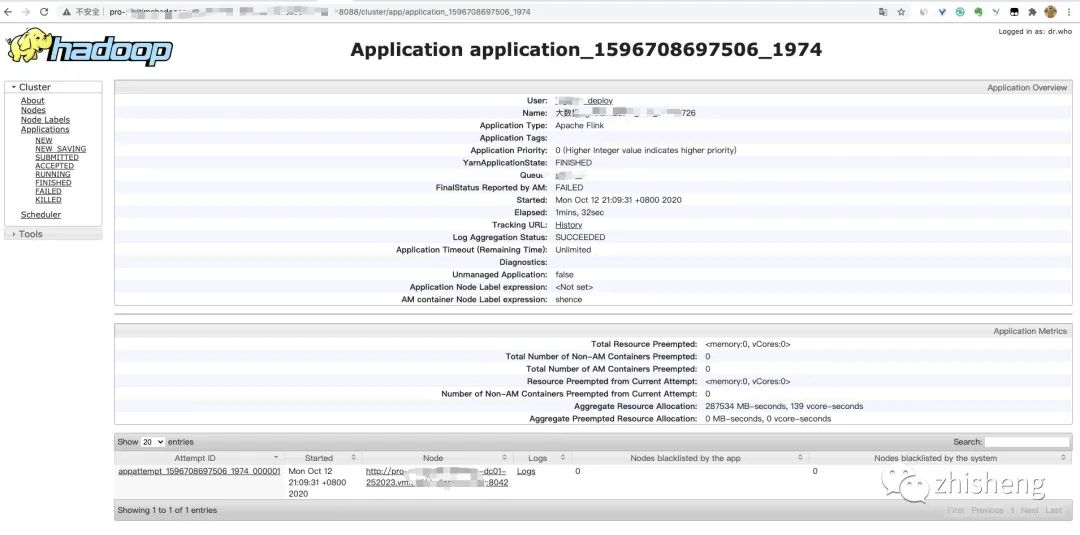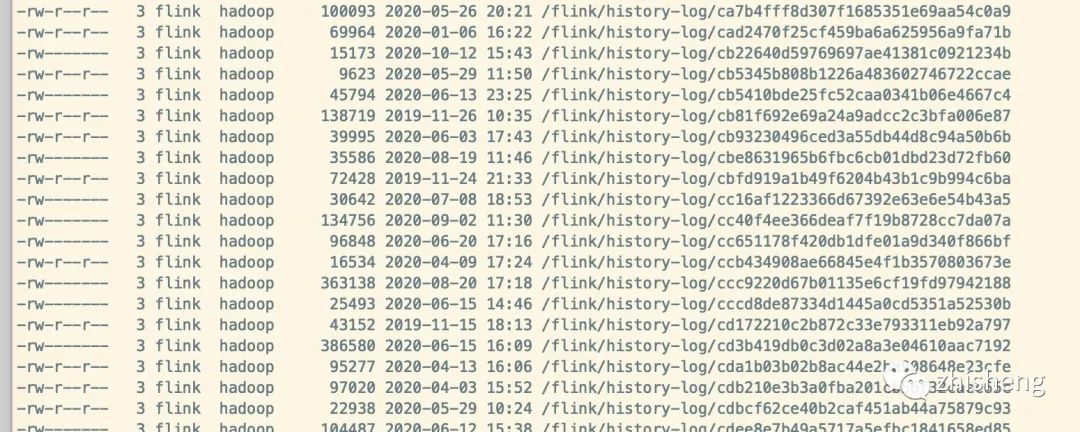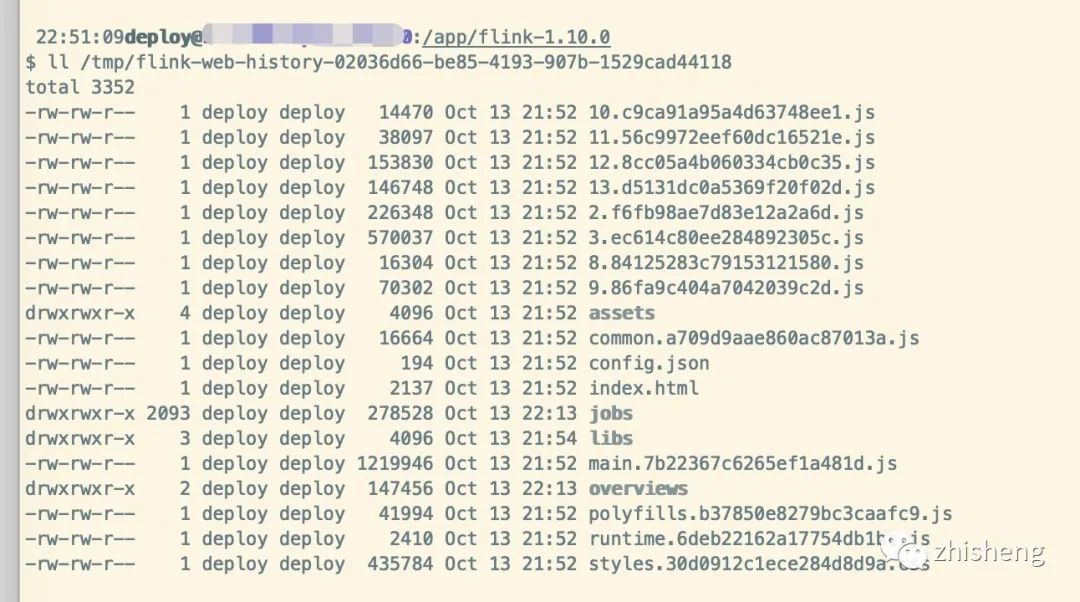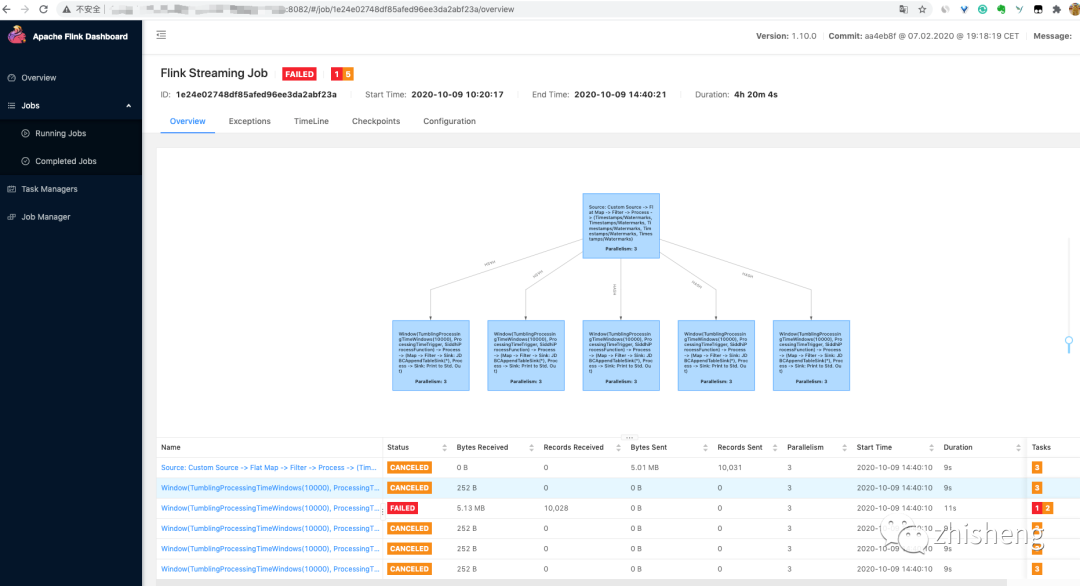前言
Flink On YARN 默认作业挂了之后打开的话,是一个如下这样的页面:

作业失败后
对于这种我们页面我们只能查看 JobManager 的日志,不再可以查看作业挂掉之前的运行的 Web UI,很难清楚知道作业在挂的那一刻到底发生了啥?如果我们还没有 Metrics 监控的话,那么完全就只能通过日志去分析和定位问题了,所以如果能还原之前的 Web UI,我们可以通过 UI 发现和定位一些问题。
History Server 介绍
那么这里就需要利用 Flink 中的 History Server 来解决这个问题。那么 History Server 是什么呢?
它可以用来在相应的 Flink 集群关闭后查询已完成作业的统计信息。例如有个批处理作业是凌晨才运行的,并且我们都知道只有当作业处于运行中的状态,才能够查看到相关的日志信息和统计信息。所以如果作业由于异常退出或者处理结果有问题,我们又无法及时查看(凌晨运行的)作业的相关日志信息。那么 History Server 就显得十分重要了,因为通过 History Server 我们才能查询这些已完成作业的统计信息,无论是正常退出还是异常退出。
此外,它对外提供了 REST API,它接受 HTTP 请求并使用 JSON 数据进行响应。Flink 任务停止后,JobManager 会将已经完成任务的统计信息进行存档,History Server 进程则在任务停止后可以对任务统计信息进行查询。比如:最后一次的 Checkpoint、任务运行时的相关配置。
那么如何开启这个呢?你需要在 flink-conf.yml 中配置如下:
#==============================================================================
#*HistoryServer
#==============================================================================
#*The*HistoryServer*is*started*and*stopped*via*bin/historyserver.sh*(start|stop)
#*Directory*to*upload*completed*jobs*to.*Add*this*directory*to*the*list*of
#*monitored*directories*of*the*HistoryServer*as*well*(see*below).*
#*flink*job*运行完成后的日志存放目录
jobmanager.archive.fs.dir:*hdfs:///flink/history-log
#*The*address*under*which*the*web-based*HistoryServer*listens.
#*flink*history进程所在的主机
#historyserver.web.address:*0.0.0.0
#*The*port*under*which*the*web-based*HistoryServer*listens.
#*flink*history进程的占用端口
#historyserver.web.port:*8082
#*Comma*separated*list*of*directories*to*monitor*for*completed*jobs.
#*flink*history进程的hdfs监控目录
historyserver.archive.fs.dir:*hdfs:///flink/history-log
#*Interval*in*milliseconds*for*refreshing*the*monitored*directories.
#*刷新受监视目录的时间间隔(以毫秒为单位)
#historyserver.archive.fs.refresh-interval:*10000
注意:jobmanager.archive.fs.dir 要和 historyserver.archive.fs.dir 配置的路径要一样
执行命令:
./bin/historyserver.sh*start
发现报错如下:
2020-10-13*21:21:01,310*main*INFO**org.apache.flink.core.fs.FileSystem***************************-*Hadoop*is*not*in*the*classpath/dependencies.*The*extended*set*of*supported*File*Systems*via*Hadoop*is*not*available.
2020-10-13*21:21:01,336*main*INFO**org.apache.flink.runtime.security.modules.HadoopModuleFactory**-*Cannot*create*Hadoop*Security*Module*because*Hadoop*cannot*be*found*in*the*Classpath.
2020-10-13*21:21:01,352*main*INFO**org.apache.flink.runtime.security.modules.JaasModule**********-*Jaas*file*will*be*created*as*/tmp/jaas-354359771751866787.conf.
2020-10-13*21:21:01,355*main*INFO**org.apache.flink.runtime.security.SecurityUtils***************-*Cannot*install*HadoopSecurityContext*because*Hadoop*cannot*be*found*in*the*Classpath.
2020-10-13*21:21:01,363*main*WARN**org.apache.flink.runtime.webmonitor.history.HistoryServer*****-*Failed*to*create*Path*or*FileSystem*for*directory*'hdfs:///flink/history-log'.*Directory*will*not*be*monitored.
org.apache.flink.core.fs.UnsupportedFileSystemSchemeException:*Could*not*find*a*file*system*implementation*for*scheme*'hdfs'.*The*scheme*is*not*directly*supported*by*Flink*and*no*Hadoop*file*system*to*support*this*scheme*could*be*loaded.
********at*org.apache.flink.core.fs.FileSystem.getUnguardedFileSystem(FileSystem.java:450)
********at*org.apache.flink.core.fs.FileSystem.get(FileSystem.java:362)
********at*org.apache.flink.core.fs.Path.getFileSystem(Path.java:298)
********at*org.apache.flink.runtime.webmonitor.history.HistoryServer.<init>(HistoryServer.java:187)
********at*org.apache.flink.runtime.webmonitor.history.HistoryServer.<init>(HistoryServer.java:137)
********at*org.apache.flink.runtime.webmonitor.history.HistoryServer$1.call(HistoryServer.java:122)
********at*org.apache.flink.runtime.webmonitor.history.HistoryServer$1.call(HistoryServer.java:119)
********at*org.apache.flink.runtime.security.NoOpSecurityContext.runSecured(NoOpSecurityContext.java:30)
********at*org.apache.flink.runtime.webmonitor.history.HistoryServer.main(HistoryServer.java:119)
Caused*by:*org.apache.flink.core.fs.UnsupportedFileSystemSchemeException:*Hadoop*is*not*in*the*classpath/dependencies.
********at*org.apache.flink.core.fs.UnsupportedSchemeFactory.create(UnsupportedSchemeFactory.java:58)
********at*org.apache.flink.core.fs.FileSystem.getUnguardedFileSystem(FileSystem.java:446)
********...*8*more
2020-10-13*21:21:01,367*main*ERROR*org.apache.flink.runtime.webmonitor.history.HistoryServer*****-*Failed*to*run*HistoryServer.
org.apache.flink.util.FlinkException:*Failed*to*validate*any*of*the*configured*directories*to*monitor.
********at*org.apache.flink.runtime.webmonitor.history.HistoryServer.<init>(HistoryServer.java:196)
********at*org.apache.flink.runtime.webmonitor.history.HistoryServer.<init>(HistoryServer.java:137)
********at*org.apache.flink.runtime.webmonitor.history.HistoryServer$1.call(HistoryServer.java:122)
********at*org.apache.flink.runtime.webmonitor.history.HistoryServer$1.call(HistoryServer.java:119)
********at*org.apache.flink.runtime.security.NoOpSecurityContext.runSecured(NoOpSecurityContext.java:30)
********at*org.apache.flink.runtime.webmonitor.history.HistoryServer.main(HistoryServer.java:119)
这个异常的原因是因为 Flink 集群的 CLASS_PATH 下缺少了 HDFS 相关的 jar,我们可以引入 HDFS 的依赖放到 lib 目录下面或者添加 Hadoop 的环境变量。
这里我们在 historyserver.sh 脚本中增加下面脚本,目的就是添加 Hadoop 的环境变量:
#*export*hadoop*classpath
if*[*command*-v*hadoop*];then
**export*HADOOP_CLASSPATH=hadoop*classpath
else
**echo*"hadoop*command*not*found*in*path!"
fi
效果
添加后再启动脚本则可以运行成功了,打开页面 机器IP:8082 则可以看到历史所有运行完成或者失败的作业列表信息。

作业列表信息
点进单个作业可以看到作业挂之前的所有信息,便于我们去查看挂之前作业的运行情况(Exception 信息/Checkpoint 信息/算子的流入和流出数据量信息等)
作业挂之前的运行情况
原理分析
再来看看配置的 /flink/history-log/ 目录有什么东西呢?执行下面命令可以查看
hdfs*dfs*-ls*/flink/history-log/

hdfs 文件目录
其实history server 会在本地存储已结束 Job 信息,你可以配置 historyserver.web.tmpdir 来决定存储在哪,默认的拼接规则为:
System.getProperty("java.io.tmpdir")*+*File.separator*+*"flink-web-history-"*+*UUID.randomUUID()
Linux 系统临时目录为 /tmp,你可以看到源码中 HistoryServerOptions 该类中的可选参数。
/**
**The*local*directory*used*by*the*HistoryServer*web-frontend.
*/
public*static*final*ConfigOption<String>*HISTORY_SERVER_WEB_DIR*=
****key("historyserver.web.tmpdir")
********.noDefaultValue()
********.withDescription("This*configuration*parameter*allows*defining*the*Flink*web*directory*to*be*used*by*the"*+
************"*history*server*web*interface.*The*web*interface*will*copy*its*static*files*into*the*directory.");
那么我们找到本地该临时目录,可以观察到里面保存着很多 JS 文件,其实就是我们刚才看到的页面

本地临时目录
历史服务存储文件中,存储了用于页面展示的模板配置。历史任务信息存储在 Jobs 路径下,其中包含了已经完成的 Job,每次启动都会从 historyserver.archive.fs.dir 拉取所有的任务元数据信息。

Jobs 目录
每个任务文件夹中包含我们需要获取的一些信息,通过 REST API 获取时指标时,就是返回这些内容(Checkpoint/Exception 信息等)。

具体Job
REST API
以下是可用且带有示例 JSON 响应的请求列表。所有请求格式样例均为 http://hostname:8082/jobs,下面我们仅列出了 URLs 的 path 部分。尖括号中的值为变量,例如作业 7684be6004e4e955c2a558a9bc463f65 的 http://hostname:port/jobs/<jobid>/exceptions 请求须写为 http://hostname:port/jobs/7684be6004e4e955c2a558a9bc463f65/exceptions。
- /config
- /jobs/overview
- /jobs/
<jobid> - /jobs/
<jobid>/vertices - /jobs/
<jobid>/config - /jobs/
<jobid>/exceptions - /jobs/
<jobid>/accumulators - /jobs/
<jobid>/vertices/<vertexid> - /jobs/
<jobid>/vertices/<vertexid>/subtasktimes - /jobs/
<jobid>/vertices/<vertexid>/taskmanagers - /jobs/
<jobid>/vertices/<vertexid>/accumulators - /jobs/
<jobid>/vertices/<vertexid>/subtasks/accumulators - /jobs/
<jobid>/vertices/<vertexid>/subtasks/<subtasknum> - /jobs/
<jobid>/vertices/<vertexid>/subtasks/<subtasknum>/attempts/<attempt> - /jobs/
<jobid>/vertices/<vertexid>/subtasks/<subtasknum>/attempts/<attempt>/accumulators - /jobs/
<jobid>/plan
版权声明:本文不是「本站」原创文章,版权归原作者所有 | 原文地址:
 ]
]